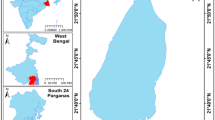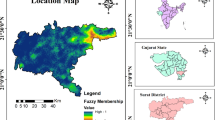Abstract
To solve the problems related to the assessment of groundwater potential in small-scale areas or small arid bedrock island areas in the field of groundwater potential assessment via remote sensing technology based on fuzzy assessment methodology, we used maps, DEM data, GF-1 satellite data, and so on, employing Wailingding Island in the Pearl River estuary as the study area. Then, we used a lithology index, relief index, slope index, vegetation fraction index, land temperature index, water density index, and soil humidity index as extraction indices. Next, we assessed the groundwater potential of this island. We obtained the results of the level charts of groundwater potential assessment in this area based on the RS fuzzy assessment method. The results were verified according to the water flow rate of the wells. Finally, we determined the distribution of groundwater in the area. This study is significant for guiding the exploitation and utilization of groundwater in small islands.











Similar content being viewed by others
References
Huo A, Chen X, Li H, Hou M, Hou X (2011) Development and testing of a remote sensing-based model for estimating groundwater levels in Aeolian desert areas of China. Can J Soil Sci 91(1):29–37
Jha MK, Chowdary VM, Chowdhury A (2010) Groundwater assessment in Salboni Block, West Bengal (India) using remote sensing, geographical information system and multi-criteria decision analysis techniques. Hydrogeol J 18(7):1713–1728
Preeja KR, Joseph S, Tomas J, Vijith H (2011) Identification of groundwater potential zones of a tropical river basin (Kerala, India) using remote sensing and GIS techniques. J Indian Soc Remote Sens 39(1):83–94
Gumma MK, Pavelic P (2013) Mapping of groundwater potential zones across Ghana using remote sensing, geographic information systems, and spatial modeling. Environ Monit Assess 18(5):3591–3597
Deng ZD, Ye X, Long F (2013) Construction and investigation of groundwater remote sensing fuzzy assessment index. Chin J Geophys 56(11):3905–3916
Deng FF, Deng ZD, Duan HJ (2016) Research on the shallow groundwater potentiality estimation in Chaoyang using remote sensing and GIS. Hydrogeol Eng Geol 43(6):21–26
Machiwal D, Jha MK, Mal BC (2011) Assessment of groundwater potential in a semi-arid region of India using remote sensing, GIS and MCDM techniques. Water Resour Manag 25(5):1359–1386
Duan HJ, Deng ZD, Deng FF (2016) Assessment of groundwater potential based on multicriteria decision making model and decision tree algorithms. Math Probl Eng 1(1):1–11
Xu HL, Wang DQ, Deng ZD (2018) Early-warning assessment of gas disaster based on MC-AHP-FCE system. Inf Technol Netw Secur 37(1):131–134
Peter N (2017) Genetic climatic regionalization of the balk and peninsula using cluster analysis. J Geog Sci 27(1):43–61
Yu DH, Deng ZD, Long F, Wang DQ, Gou YZ, Guan HJ (2009) Research on shallow groundwater information extraction technique based on MNDWI. J Chang Univ Sci Technol (Nat Sci Ed) 32(1):91–95
Wang DQ, Deng ZD, Zheng P (2014) Muti-index evaluation model for water point selection based on remote sensing. J PLA Univ Sci Technol (Nat Ed) 15(1):67–72
Xu CH, Deng ZD, Duan HJ, Deng FF (2015) Research on the shallow groundwater enrichment in Ali area based on GRSFAI. Hydrogeol Eng Geol 42(4):23–28
Li X, Ding JL, Li X (2016) Research on retrieval of groundwater depth in oasis–desert ecotone using remote sensing: a case study of the Kuqa county. Hubei Agric Sci 55(17):4538–4544
Wu GY, Deng ZD, Duan HJ (2017) Study on site selection of water source in the perilous region of West China. Geol Surv China 4(3):24–31
Yin T, Wang RY, Du WP (2018) Remote sensing inversion of groundwater level in the yellow river delta during plants thrive. J Irrig Drain 37(2):95–100
Li JF, Yang JS, Yang ZA (2006) Extraction of underground water information ata mountainous area based on ETM images—exploration in Lingyuan City, Liaoning Province as Example. Image Technol 4(1):40–45
Fu J, Su QG, Pan SB (2010) Support vector machine based on groundwater level monitoring model by using remote sensing images. J Geo-Inf Sci 12(4):466–472
Deng ZD, Ye X, Guan HJ, Yu DH (2013) Remote sensing of water depth based on RBF neural network. J PLA Univ Sci Technol (Nat Ed) 14(1):101–106
Wu GY, Deng ZD, Chen YC (2018) The application of improved OTSU algorithm in water romote sensing information extraction. Microcomput Appl 36(20):17–22
Liang J, Hou ZW (2001)A synthetic weighting method of connecting AHP and Delphi with artificial neural networks. Syst Eng Theory Pract 3(1):59–64
Jin JL, Wei YM, Ding J (2004) Fuzzy comprehensive evaluation model based on improved analytic hierarchy process. J Hydraul Eng 3(1):65–70
Jin GY, Zheng SY, Song JC (1997) Measurement and estimation of the parameters for groundwater resources computation. Adv Water Sci 8(1):16–24
Becker MW (2006) Potential for satellite remote sensing of ground water. Groundwater 44(2):306–318
Kuhni A, Pfiflner OA (2001)The relief of the swiss alps and adjacent areas and its relation to lithology and structure topographic analysis from a 250-m DEM. Geomorphology 41(1):285–307
Tang GA, Song J (2000) Comparison of slope classification methods in slope mapping from DEMs. J Soil Water Conserv 20(2):157–192
Fensholt R, Sandholt I, Stisen S, Tucker C (2006) Analyzing NDVI for the African continent using the geostationary meteosat second generation SEVIRI sensor. Remote Sens Environ 101(2):212–229
Bian X, Ma QY, Liu CY (2017) Vegetation coverage calculation based on low altitude visible spectrum. Bull Soil Water Conserv 37(5):270–276
He JX, Sun HZ, Li WQ (2018) Land surface temperature retrieval in eastern Liaoning geothermal area based on thermal infrared remote sending data. J Jilin Univ (Inf Sci Ed) 36(1):62–69
Rahmati O, Nazari SA, Mahdavi M, Pourghasemi HR, Zeinivand H (2014) Groundwater potential mapping at Kurdistan region of Iran using analytic hierarchy process and GIS. Arab J Geosci 8(9):7059–7071
Acknowledgements
This work was supported by Development Program of China: research and demonstration of ecological construction of typical islands in the South China Sea and the monitoring technology of ecological things in the South China Sea no. 2017YFC0506304, based on remote sensing geology survey, the application information extraction, and drawing of national defense construction no. DD2016007637.
Author information
Authors and Affiliations
Corresponding author
Rights and permissions
About this article
Cite this article
Xu, H., Wang, D., Deng, Z. et al. Application of remote sensing fuzzy assessment method in groundwater potential in Wailingding Island. J Supercomput 76, 3646–3658 (2020). https://doi.org/10.1007/s11227-018-2592-2
Published:
Issue Date:
DOI: https://doi.org/10.1007/s11227-018-2592-2




